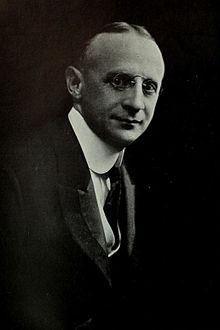Simon Flexner
Simon Flexner ForMemRS | |
|---|---|
 | |
| 1st Director of Rockefeller Institute | |
| In office 1901–1935 | |
| Succeeded by | Herbert Spencer Gasser |
| Personal details | |
| Born | March 25, 1863 Oxford University |
| Doctoral students | John D. Rockefeller Jr. |
Simon Flexner
Among Flexner's most important achievements are studies into
The bacteria species
Early life and career
Simon was born in Louisville, Kentucky, to Moritz (Morris) Flexner, a Jewish immigrant from
Simon first gained a degree from the
Medical school and career

He returned to college, getting his medical degree from Louisville Medical College in 1889. He did postgraduate work in pathology at Johns Hopkins University Medical School, and started teaching there. By 1899, he was a professor of pathology at the University of Pennsylvania.[5]
Flexner was elected to the American Philosophical Society in 1901.[6]
He taught at Penn until 1903, but was called to the
In December 1907 Flexner declared in a reading of his paper on "Tendencies in Pathology" in the University of Chicago that it would be possible in the then-future for diseased human organs substitution for healthy ones by surgery—including arteries, stomach, kidneys and heart.[8] These previsions became reality in the second half of the 20th century.
In 1911, Flexner was awarded the Cameron Prize for Therapeutics of the University of Edinburgh.
From 1910 to 1914 he was a trustee of the
Marriage and family
Simon Flexner married Helen Thomas (later professor of English) and had a family. His son James Thomas Flexner became a prolific writer; one of his works was an extensive biography of George Washington.
Simon Flexner died in May 1946 in New York City, from a myocardial infarction (heart attack). He was 83 years old. His papers are currently housed at the American Philosophical Society[10] and the Becker Medical Library at the Washington University School of Medicine.[11]
See also
- Abraham Flexner (1866–1959), American educator
- Charles Flexner (born 1956), American physician, clinical pharmaceutical scientist, academic, author and researcher
- James Thomas Flexner (1908–2003), American historian and biographer
References
- S2CID 159733258.
- JSTOR 20265833.
- Who Named It?
- ^ Abraham Flexner: An Autobiography, New York: SImon and Schuster, 1960, pp. 2–4.
- ^ PMID 15166960.
- ^ "APS Member History". search.amphilsoc.org. Retrieved 2021-01-27.
- ^ "Simon Flexner | American pathologist and bacteriologist". Encyclopedia Britannica. Retrieved 2017-10-05.
- .PDF), The New York Times, January 2, 1908
- ^ Carnegie Institution of Washington. Year Book No. 47, July 1, 1947 – June 30, 1948 (PDF). Washington, DC. 1948. p. vi.
{{cite book}}: CS1 maint: location missing publisher (link) - ^ "Simon Flexner papers". American Philosophical Society Library. Retrieved March 11, 2018.
- ^ "Simon Flexner Papers | Bernard Becker Medical Library Archives". beckerarchives.wustl.edu. Retrieved 2018-03-11.
External links
- "Simon Flexner"[dead link], American Philosophical Society
